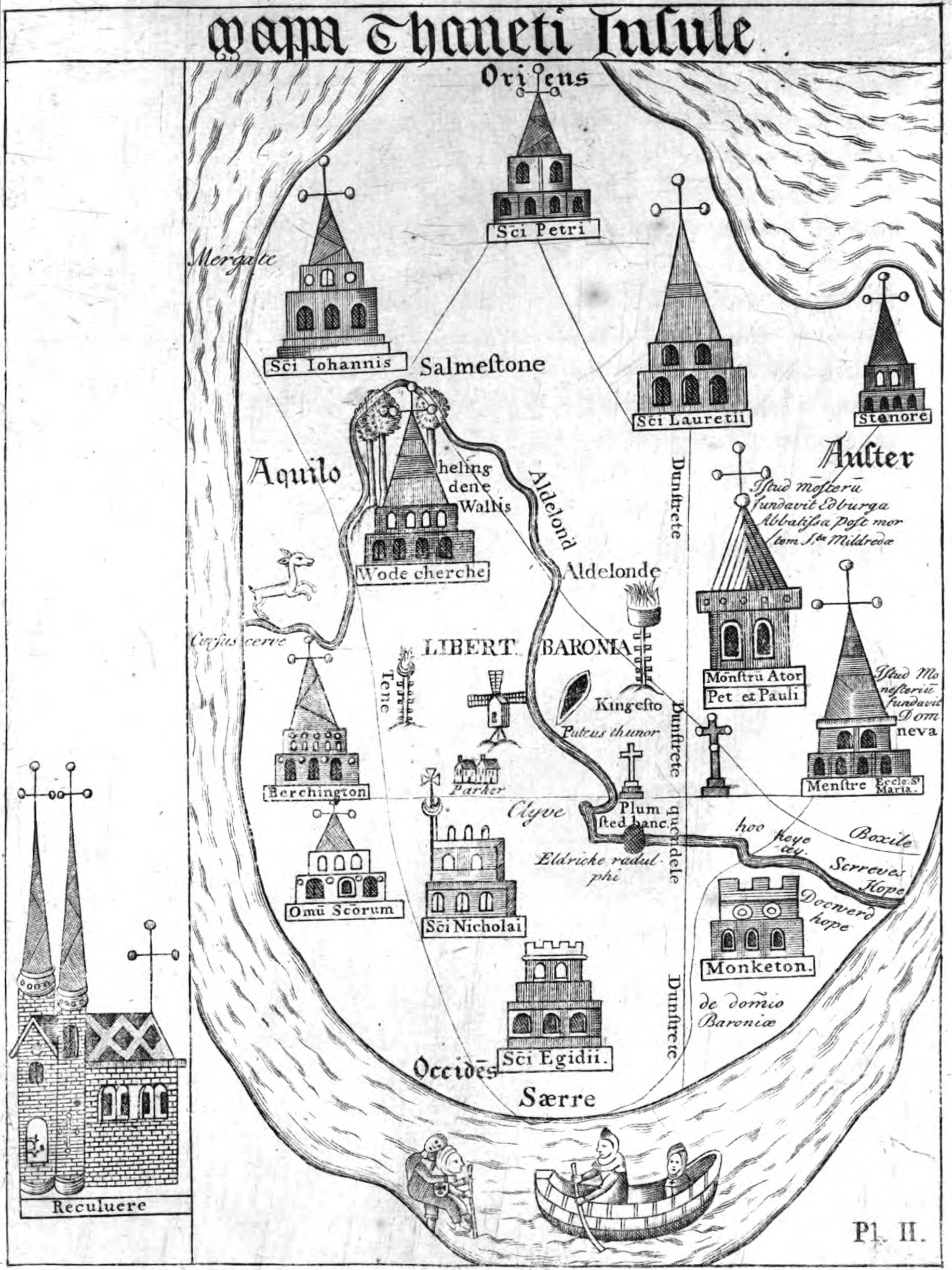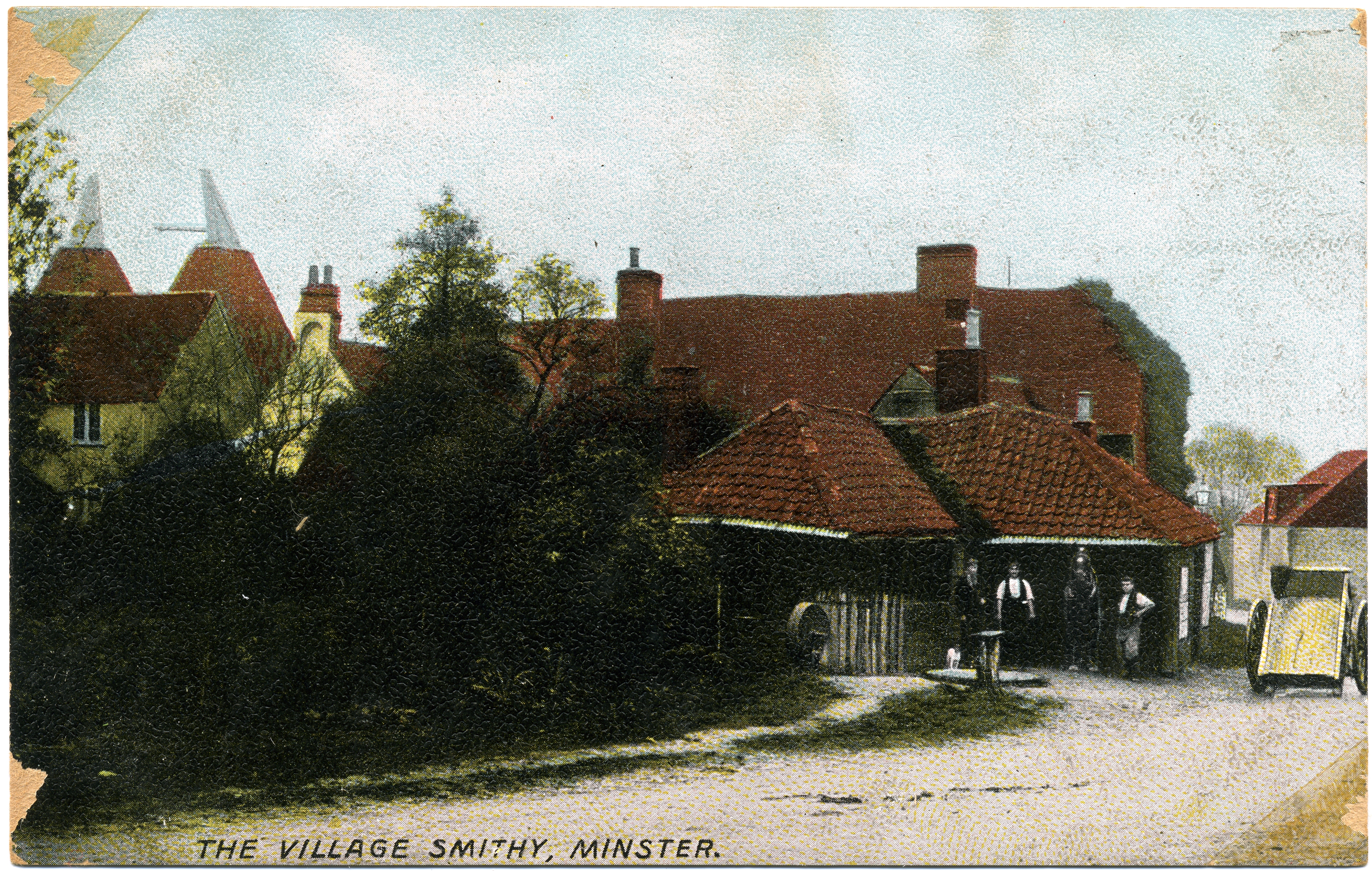|
Mildrith
Saint Mildrith, also Mildthryth, Mildryth and Mildred, () (born c. 660, died after 732), was a 7th- and 8th-century Anglo-Saxons, Anglo-Saxon abbess of the Abbey at Minster-in-Thanet, Kent. She was declared a saint after her death, and, in 1030, her remains were moved to Canterbury. Life and family Mildrith was the daughter of King Merewalh of Magonsaete, an area similar to the present day Herefordshire, a sub-kingdom of Mercia. Her mother was Domne Eafe (also sometimes named as Saint Eormenburga), herself a great-granddaughter of Æthelberht of Kent, and as such appearing in the so-called Kentish Royal Legend. Her sisters Mildburh, Milburga of Much Wenlock and Mildgytha, Mildgyth were also considered saints, and Mildrith, along with her extended family, features in the Kentish Royal Legend, also known as the "Mildrith Legend". In the 11th century, Goscelin wrote a hagiography of Mildrith, the ''Vita Mildrethae''.Rollason (1982) p. 16 Another work, the ''Nova Legenda Anglie'' of ... [...More Info...] [...Related Items...] OR: [Wikipedia] [Google] [Baidu] |
Kentish Royal Legend
The Kentish Royal Legend is a diverse group of Medieval texts which describe a wide circle of members of the royal family of Kent from the 7th to 8th centuries AD. Key elements include the descendants of Æthelberht of Kent over the next four generations; the establishment of various monasteries, most notably Minster-in-Thanet; and the lives of a number of Anglo-Saxon saints and the subsequent travels of their relics. Although it is described as a legend, and contains a number of implausible episodes, it is placed in a well attested historical context. The legend Æthelberht and his descendants Almost all the accounts begin by describing how Æthelberht of Kent was baptised by Augustine. The fullest accounts (such as Bodley 285, see below) then provide a substantial genealogy, involving not only his direct descendants but also the families some of the daughters marry into, the kings of Northumbria, Mercia, and East Anglia. The family tree below is David Rollason's summary of the ... [...More Info...] [...Related Items...] OR: [Wikipedia] [Google] [Baidu] |
Domne Eafe
Domne Eafe (; floruit late 7th century), also ''Domneva'', ''Domne Éue'', ''Æbbe'', ''Ebba'', was, according to the Kentish royal legend, a granddaughter of King Eadbald of Kent and the foundress of the double monastery of Minster in Thanet Priory at Minster-in-Thanet during the reign of her cousin King Ecgberht of Kent. A 1000-year-old confusion with her sister Eormenburg means she is often now known by that name. Married to Merewalh of Mercia, she had at least four children. When her two brothers, Æthelred and Æthelberht, were murdered (and subsequently venerated as saintly martyrs) she obtained the land in Thanet to build an abbey, from a repentant King Ecgberht. Her three daughters all went on to become abbesses and saints, the most famous of which, Mildrith, ended up with a shrine in St Augustine's Abbey, Canterbury. Origins According to the Kentish royal legend, Domne Eafe's father was Eormenred, son of King Eadbald of Kent and Emma of Austrasia, and grandso ... [...More Info...] [...Related Items...] OR: [Wikipedia] [Google] [Baidu] |
Edburga Of Minster-in-Thanet
Saint Edburga of Minster-in-Thanet (also known as Eadburh and Bugga) was a princess of Wessex, and abbess of Minster-in-Thanet. She is regarded as a saint. Life Edburga was the only daughter of King Centwine and Queen Engyth of Wessex. According to Stephen of Ripon, Engyth was a sister of Queen Iurminburh, second wife of King Ecgfrith of Northumbria. Centwine was not a Christian, but towards the end of his reign, converted and became a monk. Edburga was a friend and student of Saint Mildrith, abbess of Minster-in-Thanet."Edburga (Eadburh, Bugga) of Minster", ''The Oxford Dictionary of Saints'' (5 rev) (David Farmer, ed.) OUP, 2011 She was reputed to be zealous in the pursuit of knowledge. In 716, Edburg ... [...More Info...] [...Related Items...] OR: [Wikipedia] [Google] [Baidu] |
Minster-in-Thanet
Minster, also known as Minster-in-Thanet, is a village and civil parish in the Thanet District of Kent, England. It is the site of Minster in Thanet Priory. The village is west of Ramsgate (which is the post town) and to the north east of Canterbury; it lies just south west of Manston Airport and just north of the River Stour. Minster is also the "ancient capital of Thanet".Minster-In-Thanet ; retrieved on 22 May 2008 At the 2011 Census the hamlet of Ebbsfleet was included. Toponymy The name ultimately comes from the ''monasterium'', denoting the histor ...[...More Info...] [...Related Items...] OR: [Wikipedia] [Google] [Baidu] |
Goscelin
Goscelin of Saint-Bertin (or Goscelin of Canterbury, born c. 1040, died in or after 1106) was a Benedictine hagiographical writer. He was a Fleming or Brabantian by birth and became a monk of St Bertin's at Saint-Omer before travelling to England to take up a position in the household of Herman, Bishop of Ramsbury in Wiltshire (1058–78). During his time in England, he stayed at many monasteries and wherever he went collected materials for his numerous hagiographies of English saints. Life Flanders Goscelin of Saint-Bertin was born about 1040. According to William of Malmesbury, Goscelin was a monk of St Bertin's. On the other hand, as the author of the ''Vita Amalbergae virginis'', written before 1062, Goscelin appears to be very well informed about the hagiographic tradition in Flanders and Brabant, more especially traditions related to Saint Peter's Abbey of Ghent. He probably stayed there at some time before 1062. England According to William of Malmesbury, Goscelin a ... [...More Info...] [...Related Items...] OR: [Wikipedia] [Google] [Baidu] |
Mildgytha
Saint Mildgyth (or Mildgytha) () (died 676) was the youngest daughter of Merewalh, king of Mercia and Saint Domne Eafe, Eormenburh. She was the youngest sister of Mildburh, Saint Mildburh of Wenlock and Mildthryth, Saint Mildrith. The three sisters have been likened to the three theological virtues: Mildburh to faith, Mildgyth to hope, and Mildrith to charity. She was a Benedictine nun and later abbess of a Kingdom of Northumbria, Northumbrian convent. All that is known of St Mildgytha was that she was a nun and that “miraculous powers were often exhibited” at her tomb in Northumbria. She seems to have died long before her sisters, while still quite young, which may account for so little mention of her. Her feast day is 17 January. References External links * 676 deaths Mercian saints Anglo-Saxon nuns Benedictine nuns Anglo-Saxon abbesses 7th-century Christian saints Year of birth unknown Female saints of medieval England 7th-century English nuns 7th-century Ch ... [...More Info...] [...Related Items...] OR: [Wikipedia] [Google] [Baidu] |
Mildburh
Mildburh (alternatively Milburga or Milburgh) (died 23 February 727) was the Benedictine abbess of Wenlock Priory. Her feast day is 23 February. Life Mildburh was a daughter of Merewalh, King of the Mercian sub-kingdom of Magonsaete, and Domne Eafe. She was the older sister of Mildrith and Mildgytha. The three sisters have been likened to the three theological virtues: Milburh to faith, Mildgytha to hope, and Mildrith to charity. Mildburh was sought in marriage by a neighboring prince, who resolved to have her for his wife, even at the cost of violence. Mildburh's escape took her across a river. The prince, in hot pursuit, was forced to desist when the river miraculously became so swollen that he was unable to ford. Mildburh entered the Benedictine monastery of Wenlock, Shropshire (now known as Much Wenlock). The nunnery was founded with endowments by her father and her uncle, Wulfhere of Mercia, under the direction of a French Abbess, Liobinde of Chelles. Milburga eventua ... [...More Info...] [...Related Items...] OR: [Wikipedia] [Google] [Baidu] |
Millam
Millam () is a commune in the Nord department in northern France. A chapel dedicated to the Mercian Saint Mildrith (Mildred), Abbess of Minster-in-Thanet, who is said to have stayed there, exists in Millam, but is privately owned and not easily visited. Heraldry See also *Communes of the Nord department The following is a list of the 647 communes of the Nord department of the French Republic. The communes cooperate in the following intercommunalities (as of 2025): References Communes of Nord (French department) French Flanders {{DunkirkArrondissement-geo-stub ...[...More Info...] [...Related Items...] OR: [Wikipedia] [Google] [Baidu] |
St Augustine's Abbey
St Augustine's Abbey (founded as the Monastery of Ss Peter and Paul and changed after its founder St Augustine of Canterbury's death) was a Benedictine monastery in Canterbury, Kent, England. The abbey was founded in 598 and functioned as a monastery until its dissolution in 1538 during the English Reformation. After the abbey's dissolution, it underwent dismantlement until 1848. Since 1848, part of the site has been used for educational purposes (used as boarding houses and a library by The King's School, Canterbury) and the abbey ruins have been preserved for their historical value. From founding until dissolution In 597, Augustine arrived in England, having been sent by the missionary-minded Pope Gregory I to convert the Anglo-Saxons.England's Christian Heritage: Kent Guide at englandschristianheritage.org.uk, acce ... [...More Info...] [...Related Items...] OR: [Wikipedia] [Google] [Baidu] |
Minster In Thanet Priory
Minster Abbey is the name of two abbeys in Minster-in-Thanet, Kent, England. The first was a 7th-century foundation which lasted until the Dissolution of the Monasteries. Beside its ruins is St Mildred's Priory, a Benedictine community of women founded in 1937. History According to the Kentish Royal Legend, Minster Abbey was a double monastery founded AD 670 by Domne Eafe or Domneva; Eormenburg or Ermenburga is either her original name or that of her sister. Domne Eafe was a Kentish princess who accepted land for a house of prayer as Weregild for the killing of her brothers Æthelred and Æthelberht. The story is that she was granted as much land as her pet deer could define in a day, whence the deer used to symbolise Minster-in-Thanet. The boundary so defined is shown on mediaeval maps, and has been called the Cursus Cerve or St Mildred’s Lynch. Domne Eafe was succeeded as abbess in about 700 by her daughter Mildrith (Mildred), who was succeeded by Edburga, daughter of King ... [...More Info...] [...Related Items...] OR: [Wikipedia] [Google] [Baidu] |
Bronze Casket For St Mildred's Relics
Bronze is an alloy consisting primarily of copper, commonly with about 12–12.5% tin and often with the addition of other metals (including aluminium, manganese, nickel, or zinc) and sometimes non-metals (such as phosphorus) or metalloids (such as arsenic or silicon). These additions produce a range of alloys some of which are harder than copper alone or have other useful properties, such as strength, ductility, or machinability. The archaeological period during which bronze was the hardest metal in widespread use is known as the Bronze Age. The beginning of the Bronze Age in western Eurasia is conventionally dated to the mid-4th millennium BCE (~3500 BCE), and to the early 2nd millennium BCE in China; elsewhere it gradually spread across regions. The Bronze Age was followed by the Iron Age, which started about 1300 BCE and reaching most of Eurasia by about 500 BCE, although bronze continued to be much more widely used than it is in modern times. Because historical artworks we ... [...More Info...] [...Related Items...] OR: [Wikipedia] [Google] [Baidu] |
Pas-de-Calais
The Pas-de-Calais (, ' strait of Calais'; ; ) is a department in northern France named after the French designation of the Strait of Dover, which it borders. It has the most communes of all the departments of France, with 890, and is the 8th most populous. It had a population of 1,465,278 in 2019.Populations légales 2019: 62 Pas-de-Calais INSEE The Calais Passage connects to the Port of Calais on the . The Pas-de-Calais borders the departments of [...More Info...] [...Related Items...] OR: [Wikipedia] [Google] [Baidu] |




